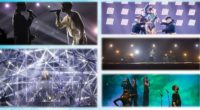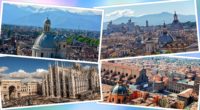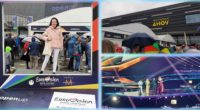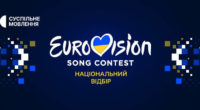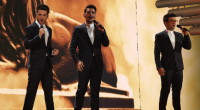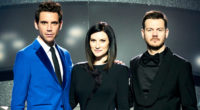
Last year in Dusseldorf, Italy ended its 14 year absence from the Eurovision Song Contest with a second place. Perhaps heartened by this result, RAI have again entered the contest. Because of the return of Italy last year, Eurovisionary published a history of the festival, which we publish a revised version of here.
It all began on the Italian Riviera in 1951 in the resort’s famous casino. It was the idea of flower seller and political activist, Amilicare Romboldi, although he needed the help of Pier Busseti (president of the company that owned the casino) and radio director Giulio Pazzi to make it happen. The festival lasted a week, a tradition which still exists today.
There were 20 songs in the first festival, however, only three artists performed them; Nilla Pizzi, Duo Fassano and Achille Togliani. Most of the songs were sung by just one of the three, although six were sung by two of them. Sanremo is not only famous for the music festival, it is also known for the flower market. How appropriate then, that one of Nilla Pizzi’s songs, Grazie dei Fiori (Thanks for the Flowers), won. She also finished second with La Luna Si Veste L’Argento. In fact, Nilla dominated the first three festivals. In 1952, she not only won with Vola Colomba, her songs took the top three places. In 1953, she finished second behind Flo Sandon’s’ Viale D’Autunno.
When Italy entered the first Eurovision Song Contest in 1956, the two songs sent were the first and second placed songs from the festival, Aprite le Finestre and Amami Se Vuoi, sung by their original artists.
The popularity of the festival quickly grew, becoming a truly multi artist event in 1961. The festival had an important place in the Italian culture and calendar and RAI wanted to make it an even bigger event. To this end, the festival remained in San Remo, but moved in 1977 to the Teatro Ariston, its current home. The result was an immediate increase in sales of the competing songs.
In 1984, the rules stipulated that singers could only use a backing track, and the orchestra disappeared. In a country where tradition and authenticity of product are considered very important, this move was not greeted with universal approval, and the orchestra returned in 1990.
Another change in 1984 was the introduction of a new competition. The Nuove Proposte or Novitá, as it is sometimes known, gave up and coming singers and bands a shot at the big time. This element of the festival has provided a springboard for talents such as Eros Ramazzotti, Laura Pausini and Andrea Bocelli, three of the biggest names in world music, to launch their careers.
To keep the festival looking fresh, RAI has experimented with different methods of producing a result. It used to be that all singers and songs stayed in the festival until the final evening. Songs would be sung on three of five evenings. The first evening would be a chance for the public to hear all the songs. Half would then compete and be voted for over the next two evenings. The results for each evening were given at the end of the show. Everyone would then perform on the final evening and face the last round of voting. A system of splitting everyone into four sections was tried in 2005. The categories were; males, females, groups and classic artists, with five acts in each section. One was eliminated each night from each section, with the overall winner of the festival emerging from the pack on the Ultima Serata. This only lasted a couple of years and a combination of methods was introduced in 2007. Established acts in one bunch, Nuove Proposte in their competition, with an act being voted out each night by a combination of a public vote and a jury known as La Guiria Demoscopica.
While its critics have grown in number, accusing the festival and its organisers of, among other things, becoming irrelevant, it seems the Italian public still love it. The last night of the festival always attracts around a 50% share of the television audience. This is lower than it used to be, but, in the era of multi channel television, half of all viewers watching one channel is something to be proud of.
This being Italy, the story wouldn’t be complete without allegations of corruption. Pippo Baudo was the face of the festival in the 1980’s and 1990’s. He presented the festival many times and was also a major player in the organising committee. He faced charges of taking bribes, charges he predictably denied. It is worth noting, however, that a certain brand of mineral water which was very prominently advertised during the Baudo years was no longer advertised when he stopped presenting the festival. His absence was not permanent, he returned in 2002.
Long before the Eurovision Song Contest started using a combination of phone votes and juries to decide the outcome, Sanremo employed such a system. This has led to some very interesting scenes and results. In 1993, the hot favourite with the audience in the Ariston was Renato Zero and his immaculately beautiful Ave Maria. Host Pippo Baudo was announcing the results in reverse order and, horror of horrors, Renato was fifth!! This caused howls of derision and disgust from the audience. So much so, that they were still venting their anger when Grazia di Michele and Rosana Casale were brought on to the stage to accept their prize for finishing third. They were visibly shaken and Pippo had to appeal for calm. In 2000, Piccola Orchestra di Avion Travel were 11th in the public vote, but after the votes of the jury had been added, they were propelled into first place. Needless to say, it wasn’t the best selling song from the festival that year! Even the festival orchestra are not immune from showing what they think. In the 2010 festival, when Malika Ayane was eliminated from the festival by the public, they shouted their disapproval. Then when Noemi was announced as the next singer eliminated, they threw their music sheets into the air while host Antonella Clerici struggled to keep order.
Most people have an idea of what a classic Italian song should sound like; emotive power, soaring strings and plenty of sincerity and commitment. It would be fair to say that this style has dominated the festival over the years. However, many other genres have been welcomed and found a place; from operatic numbers to jazz, blues, pop, rock and rap to the downright bizarre, nothing has been excluded. Composers have always been given the freedom to express themselves. There is no time limit for a song, allowing it to be developed at its own pace rather than being forced to impress within a certain timeframe.
The festival was always allowed each generation to mix with some legends of Italian music. Inevitably, the festival has been used to reignite and prolong a flagging career, but the big names have never been afraid of losing to a new kid in town while at their peak. Artists such as Claudio Villa, Domenico Modugno, Anna Oxa, Al Bano, Iva Zanicchi, Mia Martini and Massimo Ranieri, names that will live forever, have all made multiple appearances at the festival.
Incredibly, this will be the 62nd Sanremo Festival. As long as it responds to change while remaining faithful to Italian musical identity, if it gives the public what it wants while avoiding submitting to the lowest common denominator, there is no reason why the festival won’t celebrate its centenary.
The festival was won last year by Roberto Vecchioni singing Chiamami Ancora Amore (Love Still Calls to Me). Raphael Gualazzi won the Newcomers section and went to Dusseldorf to represent Italy with Follia d’Amore (The Madness of Love)
As happened last year, the Italian song will be chosen from one of the
participants in the Sanremo festival, which starts on Tuesday.






